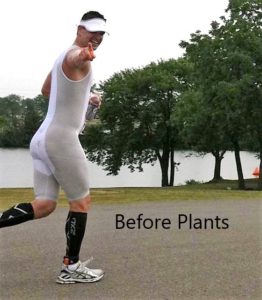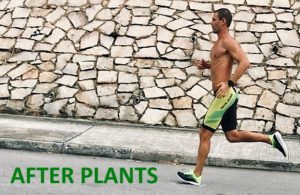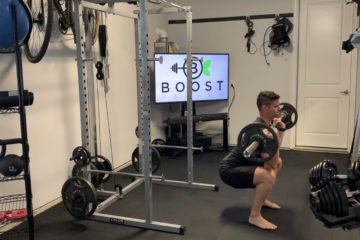

Fear of the Unknown
“I feel like I have a basketball in my stomach”, I said to my friend Tanner as we jogged down the road. We were on the second run of a bike, run, bike, run, double brick session. It was the end of summer of 2013 and we were heading into the multi-sport offseason. I had just started competing in amateur multi-sport races such as duathlons and triathlons the year prior. I was getting faster but not at the rate I expected and I felt awful all the time. Tanner said “It is probably all that meat you are eating”. I laughed at first not realizing he was somewhat serious. I had been dealing with stomach pain and bloating every time I would train, especially on the runs. I started even noticing stomach discomfort in my strength training sessions and sometimes even when I didn’t train at all. I had tried training where I didn’t eat 2, 3, and 4 hours before workouts and that didn’t help. I tried fasted morning workouts and there was no improvement. Tanner made it clear that he was not joking and had in fact been eating a plants based diet that entire year and was feeling good. I was curious. I wanted to feel better and wondered if something in the animal products I was consuming was bothering me. “Where do you get your protein?” I asked. Now I hate myself for asking that question because it is ridiculous, but at the time I did not know any better. At that time I had worked in the fitness and healthcare industry for over 13 years and was a Certified Strength and Conditioning Specialist. I had a degree in Human Biology. I took courses in nutrition at KU and for my certification. I feel like I should have known better. “I get plenty of protein”, Tanner said.
Dairy Addiction
A few days later I got a text from Tanner saying I should have a listen to the Rich Roll Podcast. Rich is a well-known plant power endurance athlete and successful podcaster. I listened to one episode where John Joseph was a guest and I was immediately inspired to try a plants based diet! The next day I dropped meat from my diet and two days later I cut out dairy and all other animal food sources. I didn’t feel much different when I cut meat out those first few days but when I got rid of dairy it was major. I had absolutely horrible headaches and felt sluggish for two days. It seems that I was having some type of withdrawal from dairy. Yes I know, 1 million different things can cause headaches but I was fairly careful to remove all variables and do everything exactly the same as I normally would, just without the animal products. All you have to do is a Google search on opiates in dairy and you will arrive at a firestorm of opinions on whether or not the science is good enough to declare dairy as addictive. My opinion is that dairy and I did not jive, but due to the addictive properties I kept coming back for more, and then when I cut it out completely one day, my body had withdrawals in the form of headaches. Then after the 2 days of headaches were over I started to feel better. Initially, and foolishly, I inserted soy products in place of many of the dairy items I was consuming such as soy milk, tofu, soy yogurt, soy ice cream, etc. I later found out that soy and I do not get along very well either, but I will cover that as a blog podcast topic on its own later. In short, I was trying to replace everything that I was formally taking in with dairy…which really wasn’t necessary.
Protein Boy
I dove straight into the deep end, as you might say, and have been eating plants-based ever since September 12, 2013. I did not do it for philosophical reasons. Notice I didn’t say “vegan”. Even though I technically am a vegan, from a nutritional standpoint, I think that sadly there is some negative connotation that comes with the “v word”. Perhaps some vegans in the past have been so passionate about their cause that they came off as pushy or scornful to those around them. That said, if me not eating animal products helps save a few animals and reduces my carbon footprint a wee bit, then that is a fantastic. I just do not want to make grandiose statements about trying to save the world with my switching to plants based fueling. I was being totally selfish. I just wanted to feel better and perform better. I was also very nervous about losing strength and muscle mass. I was coming from the old school body builder mentality of meals of skinless boneless chicken breast, brown rice, and broccoli, and 5 day split strength workouts training specific muscle groups, and most importantly of all PROTEIN. God forbid a gym rat to not ingest 1 gram of protein per pound of bodyweight per day. You would shrivel up and die would you not? I had been practicing and preaching that since I first was certified as a personal trainer in my college days. And now I was going to only eat plants.
What I did not realize was two very important things. First plants are an excellent source of protein and second we likely do not need as much protein as we have been told up until recent years. Dr. Axe has a great review on plant protein sources and you may be surprised to learn that green peas have 9 grams of protein per serving and lentils have 18 grams of protein per serving! What is the proper amount of protein to take in? Well of course that depends on a lot of factors for each individual such as activity level, fitness goals, and ability to assimilate the food source. One tool that may be helpful in determining protein and other nutrients needs is dietary reference intakes (DRIs). This free tool provided by the United States Agricultural Library actually allows the user to input their gender, age, height, weight, and activity level, as well as what macronutrients, vitamins, and minerals they want to review. Then the tool will provide recommendations based on your inputs. For my inputs of a 39 year old male, 6 feet tall, 170 pounds, and highest activity level it recommended only 62 grams of protein. When considering this, and the fact that plants can be an excellent source of protein, there really shouldn’t be a concern about cutting out animal products.
The Truth is in the Body Composition
I mentioned I was scared about losing muscle and strength. In fact, I vowed that if I lost even 1 percent of my muscle mass that I was going to throw in the plants-based towel. I was very pleased to see almost immediate progress. I was already tracking body composition closely with my Omron scale that uses bioelectrical impedance to measure skeletal muscle and body fat percentage among other metrics. Below is the link to the one I purchased in 2010. Quite a bit cheaper now and still works fantastic.
While you can argue that bioelectrical impedance is not 100 percent accurate, it is fairly consistent. This is important as it should accurately measure progress over time. I was careful to measure the same way each time: in the morning after waking up, after voiding the bowels and bladder, naked, and no intake of any drink or food. You can see in my chart below that after being on a plants-based diet for about 1 month I had lost about 5 pounds, lost about 3 percent body fat, and gained about 1.5 percent muscle! I continued to steadily lose overall mass while gaining muscle and losing fat over the months and years to come. 4 years after starting a plants only diet I am down about 15 pounds in total mass, have about 10 percent less body fat, and about 5 percent more muscle mass.
Endurance Performance
Clearly the body composition data shows much improvement over time. But what about performance? As you might expect, I got faster in the endurance races I participated in. Just from the weight loss alone you would expect to see increased speed. There were other elements, though, that had a part in improved endurance performance. One of the most important ameliorations after switching to plants was ability to train without stomach issues. I also felt like I was recovering faster in that I was less sore after big workouts and able to increase volume a bit more than in the past. A good evaluation of this improved endurance is the sprint triathlon race I have done every year since before I started plants-based. I shaved 26 minutes off of my time the first year I did the race on plants-based and have steadily improved the time each year thereafter. Admittedly, you certainly can improve in endurance races with experience, better equipment, and ongoing training, but I would argue that plants had as big an impact as anything for me.
Strength Performance
I was feeling better. I was faster in my endurance disciplines. Good and good. But I did not want to lose strength and muscle mass. I kept doing my strength workouts that I was doing before switching to plants-based nutrition. It was a full body program on Mondays, Wednesdays, and Fridays and mostly included exercises that train the body as a big kinetic chain like squats, pullups, cleans, presses, etc. I would incorporate rehab/prehab movements as needed and occasionally add new movements as I would come across them but for the most part the strength program had very few variables or changes before or after I started on plants-based. I shared above that I was able to actually increase percentage of muscle mass from a body composition standpoint. I am happy to announce that I did not lose any strength after changing to plants-based. In fact, I saw notable improvements in some of the exercises that I performed consistently such as pull-ups and push-ups. This may have been due mostly to reduced overall body mass. The important fact to note, however, is that I did not wither away into a skin and bones weakling. I maintained my strength and muscle mass on a plants-based diet and felt as good as I ever had.
Try New Things!
After I starting seeing such amazing results after the first few months of plant-based nutrition I wanted everyone to try it. I did not want to brag about my results. I wanted to share knowledge. I felt like I was given a gift that was absolutely life-changing for me and I wanted everyone I knew to benefit from it. A few of my friends actually tried going plants-based for a while but struggled with it. They found that they did not feel great and missed foods that they had come accustomed to eating. Other friends have tried plants-based or even just limiting animal products a bit more and have had great results. Does this mean that some tried harder than others? I don’t think so. I think that plants-based nutrition may not necessarily be for everyone. I give credit to my friends for at least giving it a try. Being open to new ideas is very powerful. If I had not been open to my friend Tanner’s suggestion of plants-based nutrition I could possibly still be running with a basketball in my tummy, or worse yet, could have given up on running altogether. Maybe plants-based nutrition is for you or maybe it isn’t. My point is to just try new things and listen to new concepts. A life changing idea might just be hidden under one of your preconceived notions…
Podcast: Play in new window | Download
Subscribe Apple Podcasts | Google Podcasts | RSS







